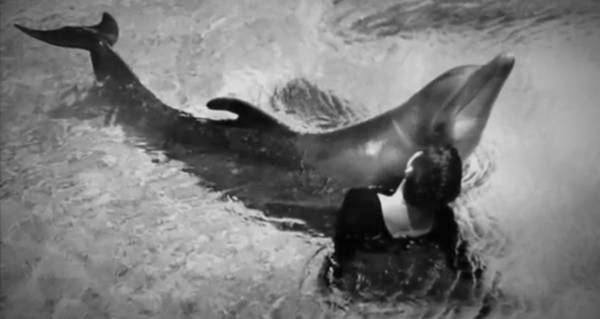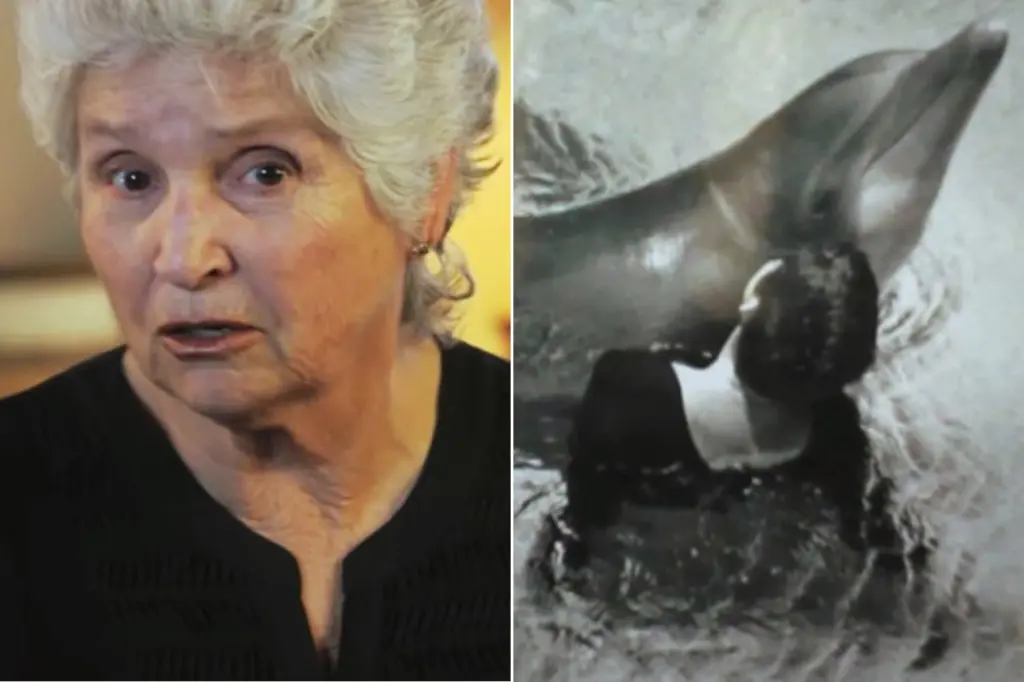Margaret Howe Lovatt: Exploring the Complex Relationship Between Woman and Dolphin
Margaret Howe Lovatt’s unique and profound connection with a dolphin named Peter is one of the most fascinating and controversial tales in the world of animal behavior studies. Her story, set against the backdrop of 1960s research, raises compelling questions about the boundaries between human and animal emotions, communication, and ethical practices. This article delves into Lovatt’s extraordinary experience, the implications of the research, and its lasting legacy.
The Genesis of the Dolphin-Human Interaction

Margaret Howe Lovatt began her career as a research assistant at a time when the study of animal behavior was undergoing revolutionary changes. Her involvement in a groundbreaking project aimed at understanding dolphin communication led her to work closely with Peter, a bottlenose dolphin. This research was part of a larger study spearheaded by the renowned scientist Dr. John Lilly, who was exploring the potential for interspecies communication.
Peter the dolphin was the focal point of this ambitious project, which sought to decipher whether dolphins could understand human language and interact with humans in a meaningful way. Lovatt’s role was pivotal as she immersed herself in Peter’s world, living in the same space and engaging with him daily. The experiment aimed to explore not only the cognitive abilities of dolphins but also the emotional bonds that could form between humans and these intelligent creatures.
Immersion into the World of Dolphins
The research setup involved a unique environment where Margaret Howe Lovatt and Peter the dolphin lived together in a specially designed aquatic enclosure. The goal was to create a setting that would facilitate natural interaction and communication. Lovatt’s responsibilities included daily interactions, training sessions, and observing Peter’s responses to various stimuli.
Key Aspects of the Research:
- Environmental Setup: A semi-aquatic environment designed to mimic natural conditions for Peter.
- Interaction Goals: To understand the depth of communication possible between humans and dolphins.
- Lovatt’s Role: Facilitating interactions, monitoring behavioral responses, and participating in training exercises.
This immersive approach was intended to create a close bond between Lovatt and Peter, enhancing the likelihood of successful communication and understanding.
The Relationship Development

As the research progressed, the relationship between Margaret Howe Lovatt and Peter the dolphin deepened. Lovatt reported experiencing a strong emotional connection with Peter, which she described as a form of mutual affection and understanding. This bond was central to the research’s aims and provided valuable insights into the emotional and psychological aspects of human-animal relationships.
Key Points:
- Emotional Bond: Lovatt and Peter developed a deep connection, which Lovatt described as akin to a romantic relationship.
- Communication Breakthroughs: The interactions revealed that dolphins could respond to human cues in sophisticated ways.
- Challenges: The experiment faced challenges, including ethical concerns and difficulties in maintaining clear boundaries between human and animal interactions.
The Impact and Implications
The experiment’s results had significant implications for the study of animal behavior and interspecies communication. Lovatt’s experiences and the data collected contributed to a broader understanding of dolphin cognition and emotional capabilities. However, the research also sparked considerable ethical debates regarding the nature of the interactions and the well-being of the animals involved.
Impact Highlights:
- Scientific Contributions: Enhanced understanding of dolphin behavior and communication.
- Ethical Concerns: Raised questions about the ethical treatment of animals in research.
- Public and Academic Response: Mixed reactions from the scientific community and the public.
The Legacy of the Experiment
Margaret Howe Lovatt’s work with Peter the dolphin left a lasting legacy in the field of animal behavior studies. The research contributed to subsequent studies on dolphin communication and cognitive abilities. Lovatt’s personal story also became a subject of interest in media and popular culture, influencing how human-animal relationships are perceived and studied today.
Legacy Aspects:
- Influence on Future Research: Provided a foundation for further studies on dolphin cognition.
- Cultural Impact: Featured in documentaries and media, shaping public perceptions.
- Lovatt’s Current Work: Continued engagement in animal behavior research and advocacy.
Key Figures and Influences
Dr. John Lilly, the leading scientist behind the project, played a crucial role in shaping the research’s direction. His theories on dolphin intelligence and communication were groundbreaking, influencing the study’s methodology and objectives. The cultural and scientific context of the 1960s also played a role in framing the research.
Notable Figures:
- Dr. John Lilly: Pioneer in dolphin research and communication studies.
- Research Team: Collaborators who supported the project and contributed to its development.
- Cultural Influences: The 1960s counterculture movement’s impact on scientific exploration and human-animal relationships.
Ethical Debates and Criticisms

The ethical dimensions of the research were a major point of contention. Critics questioned the morality of the interactions and the potential for psychological impact on both Lovatt and Peter. The debate highlighted the need for ethical guidelines in animal research and prompted discussions about the boundaries of scientific inquiry.
Key Ethical Concerns:
- Human-Animal Boundaries: Issues related to maintaining appropriate boundaries in research settings.
- Animal Welfare: Concerns about the impact of the research on Peter’s well-being.
- Scientific Ethics: The need for ethical frameworks in conducting research involving animals.
The Human-Animal Bond in Modern Research
Today, research into human-animal bonds continues to evolve, building on the insights gained from studies like Lovatt’s. Advances in understanding animal cognition and communication have led to more nuanced approaches to studying and interacting with animals.
Modern Research Trends:
- Cognition and Communication: Improved methods for studying animal intelligence and interactions.
- Ethical Standards: Development of ethical guidelines for animal research.
- Comparative Studies: Exploration of human-animal relationships across different species.
Notable Findings and Publications
The findings from the research were documented in various publications and media coverage. These included scientific articles, books, and documentaries that explored the implications of the experiment and its impact on the field of animal behavior.
Publications and Media:
- Scientific Papers: Articles detailing the experimental results and analyses.
- Books and Documentaries: Media representations of Lovatt’s story and the research.
- Ongoing Relevance: Continued discussion and analysis of the research’s impact.
Margaret Howe Lovatt’s Life Today
After the experiment, Margaret Howe Lovatt continued to engage with the field of animal behavior. Her experiences with Peter have remained a significant part of her public persona, influencing her work and advocacy in animal research.
Current Activities:
- Advocacy: Promoting ethical practices in animal research.
- Public Engagement: Speaking engagements and media appearances.
- Research Contributions: Ongoing involvement in studies related to animal behavior.
Media and Cultural Depictions
Lovatt’s story has been portrayed in various forms of media, including films and documentaries. These portrayals have shaped public perceptions and sparked discussions about the nature of human-animal relationships.
Media Representations:
- Documentaries: Films exploring the research and Lovatt’s experiences.
- Books and Articles: Written accounts of the story and its implications.
- Public Perception: How media has influenced the public’s understanding of the research.
Summary of Key Points
Margaret Howe Lovatt’s relationship with Peter the dolphin is a compelling example of human-animal interaction. Her work has had a lasting impact on animal behavior studies and continues to provoke thought and discussion about the ethical dimensions of scientific research.
Meta Description
Explore Margaret Howe Lovatt’s unique relationship with Peter the dolphin, its implications for animal behavior studies, and its lasting legacy in this comprehensive article.
References:
- History Defined – Margaret Howe Lovatt https://www.historydefined.net/margaret-howe-lovatt/
- Wikipedia – Margaret Howe Lovatt https://en.wikipedia.org/wiki/Margaret_Howe_Lovatt
- The Dolphin Research Center https://dolphins.org/






